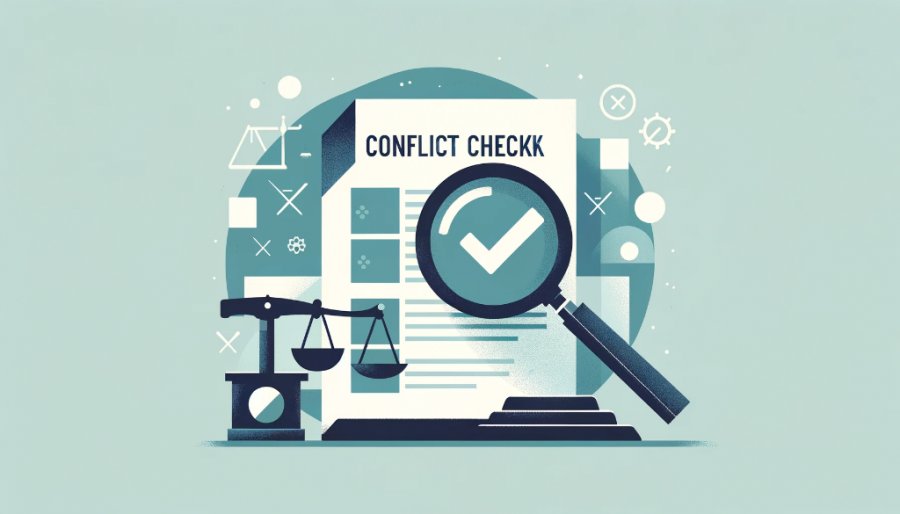Law Firm Conflict Check: Ensuring Ethical Compliance and Client Trust

In the intricate world of legal practice, maintaining ethical standards and ensuring legal compliance are paramount. Central to these objectives is the process of conducting a conflict check, a crucial step for any law firm before taking on a new client or case. This article delves into the complexities and nuances of law firm conflict checks, shedding light on their significance, the process involved, and the best practices to ensure their effectiveness.
Understanding Conflict Checks
Definition and Importance
A conflict check is an essential procedure undertaken by law firms to identify any potential conflicts of interest before representing a client. This process is not just a formality; it's a critical component in upholding the integrity of the legal system and the trust between a lawyer and their client. By conducting thorough conflict checks, law firms can avoid situations where their ability to fully represent a client is compromised due to conflicting interests.
Legal Requirements
The legal industry is governed by strict ethical rules and regulations, among which is the mandate to avoid conflicts of interest. These rules are laid down by legal bodies such as the American Bar Association (ABA) in the United States and similar organizations worldwide. Failure to conduct proper conflict checks can lead to severe repercussions, including legal malpractice claims, damage to reputation, and even disbarment. It's imperative for law firms to not only understand these requirements but also rigorously implement them in their daily operations.
The Process of Conducting Conflict Checks
Initial Steps
The first step in conducting a conflict check is gathering comprehensive information about the potential client and the nature of their case. This includes previous interactions, related parties, and any other details that could reveal a conflict. A systematic approach is essential here. Many firms employ detailed intake forms to ensure no critical information is missed. The accuracy of this initial data is crucial, as it forms the basis of the entire conflict check process.
Tools and Software
In today's tech-driven world, numerous tools and software solutions are available to streamline the conflict check process. These range from simple database search tools to more sophisticated software that can scan through vast amounts of data to identify potential conflicts. The advantage of such technology is not only in its efficiency but also in its ability to uncover conflicts that might be missed in a manual check. By leveraging these technologies, law firms can significantly reduce the risk of overlooking a conflict and ensure a more thorough vetting process.
Analyzing Results
Once the conflict check is completed, the next crucial step is analyzing the results. This involves a careful review of any flagged issues to determine whether they pose a real conflict. Not all flagged conflicts are genuine; some may be false positives or irrelevant to the specific case. It's essential for law firms to have a clear protocol for evaluating these results, often involving senior attorneys or an ethics committee. The decision to proceed with or decline representation is based on this analysis, balancing legal obligations with the firm's strategic interests.
Challenges and Best Practices
Common Challenges
Despite best efforts, law firms often encounter challenges in conducting conflict checks. These can range from incomplete client information, rapidly changing client relationships, to difficulties in interpreting the results. Additionally, in large firms or those with a wide range of practice areas, the sheer volume of data can make conflict checks complex and time-consuming. These challenges can lead to delays in client onboarding or, worse, undetected conflicts slipping through the cracks.
Best Practices
To mitigate these challenges, law firms should adopt best practices in their conflict check processes. This includes maintaining updated and comprehensive client databases, regular training for staff on the importance of conflict checks, and the use of advanced software tools. Regular audits of the conflict check process can also help in identifying areas for improvement. Transparency and clear communication with clients about the process are equally important to manage expectations and build trust.
Law Firm Conflict Check: Case Studies and Examples

Real-World Scenarios
Understanding the practical application of conflict checks can be best achieved through real-world examples. Consider a scenario where a law firm is approached by a new client for representation in a lawsuit. Upon conducting a conflict check, the firm discovers that it had previously represented the opponent in a related matter. Such a situation clearly illustrates a direct conflict of interest, guiding the firm's decision to decline representation to avoid ethical breaches.
Another example could involve a more nuanced situation where a conflict check reveals a potential conflict due to a lawyer's past association with a company involved in a case. These scenarios underscore the complexity of conflict checks and the need for careful analysis and judgment.
FAQs About Law Firm Conflict Check
Q: How often should a law firm update its conflict check procedures?
A: Law firms should regularly review and update their conflict check procedures, especially when there are changes in legal regulations or when new technologies become available.
Q: Can small law firms conduct effective conflict checks without sophisticated software?
A: Yes, small firms can conduct effective conflict checks using simpler tools or manual processes, though they must be more vigilant about maintaining accurate and up-to-date records.
Q: What should a law firm do if a conflict is identified after representation has begun?
A: If a conflict is identified after representation has begun, the firm should evaluate the situation's severity and may need to withdraw from the representation, often after consulting with an ethics counsel.
Conclusion
In conclusion, the practice of conducting conflict checks is an indispensable part of legal ethics and client representation. Law firms, irrespective of their size, must prioritize this process to uphold their professional integrity and comply with legal standards. On our site we have listed a large number of law firms, such as Yi Law Group, Brandis Bradley and more. By understanding the nuances of conflict checks, employing the right tools and best practices, and staying vigilant to the ever-evolving legal landscape, law firms can effectively navigate potential conflicts and maintain the highest standards of legal practice.
More to Read:
Previous Posts:










